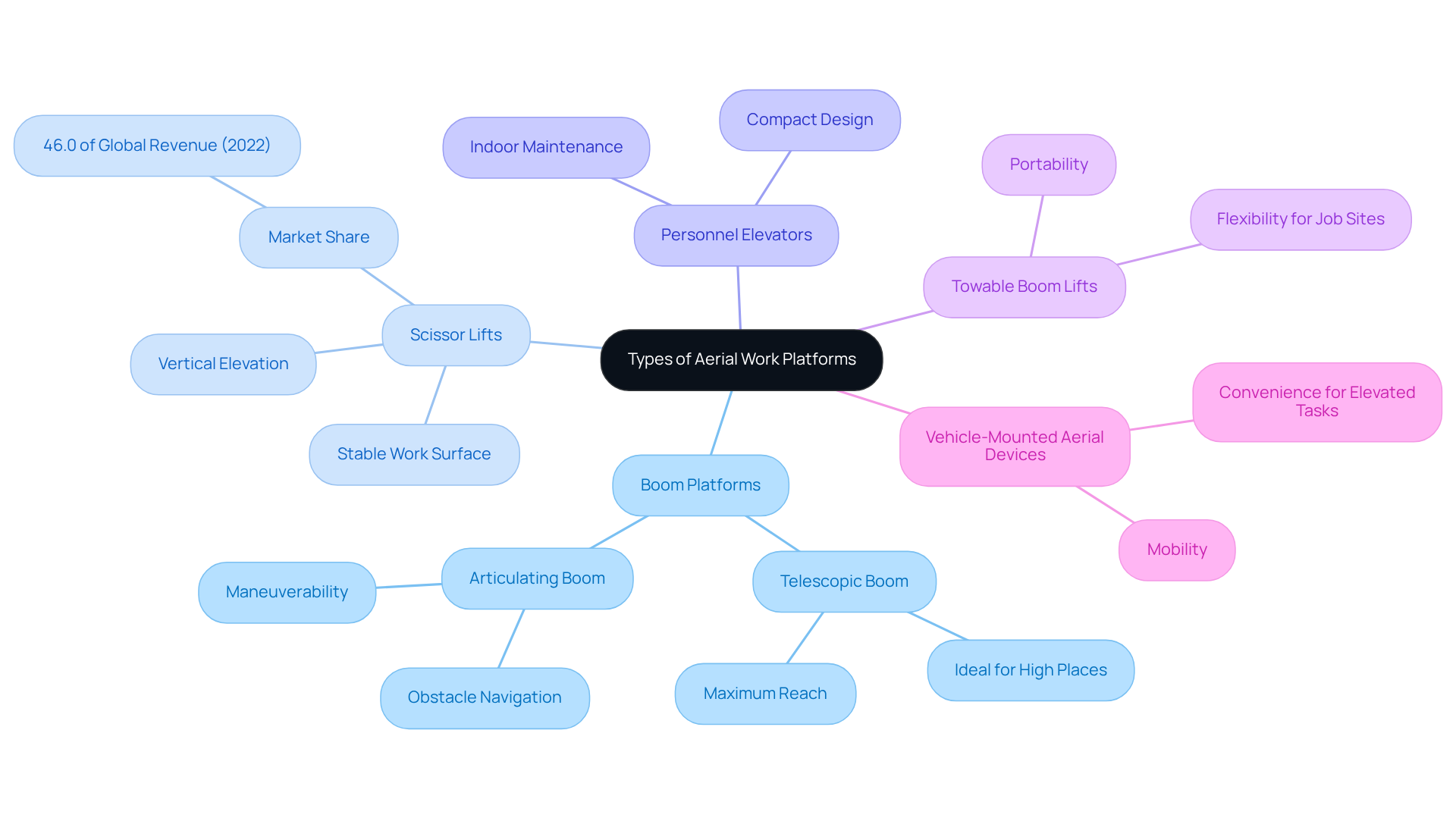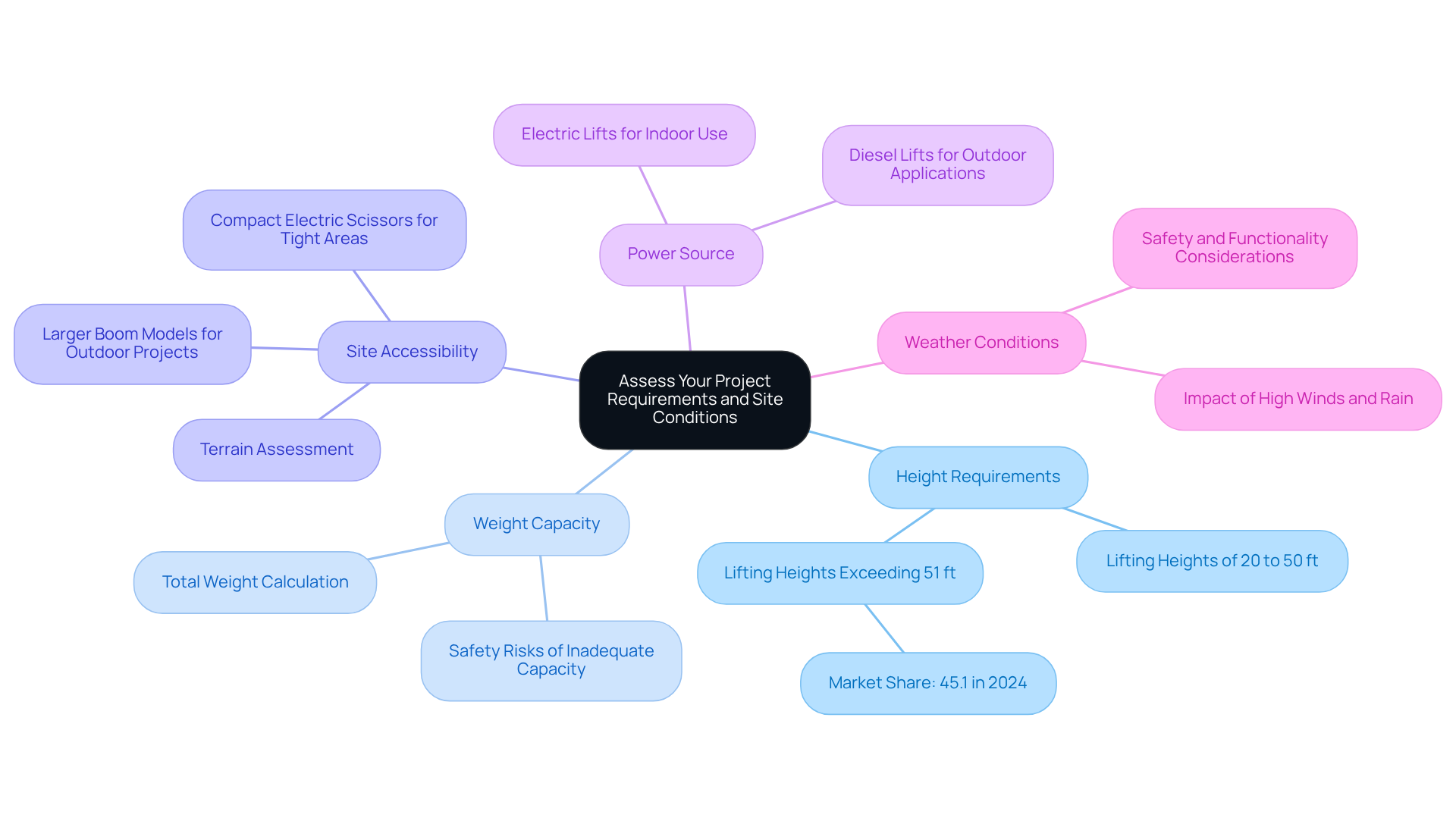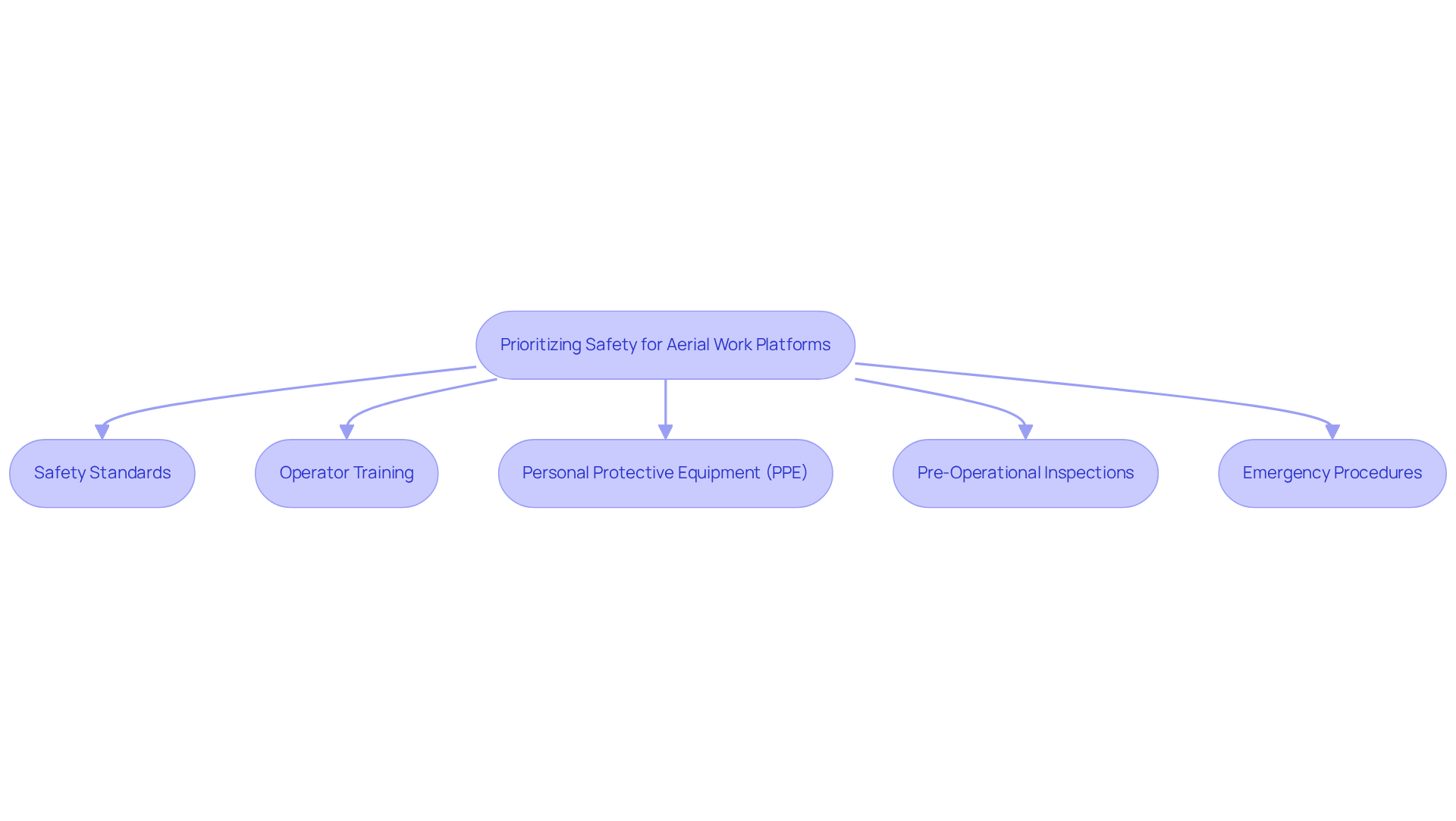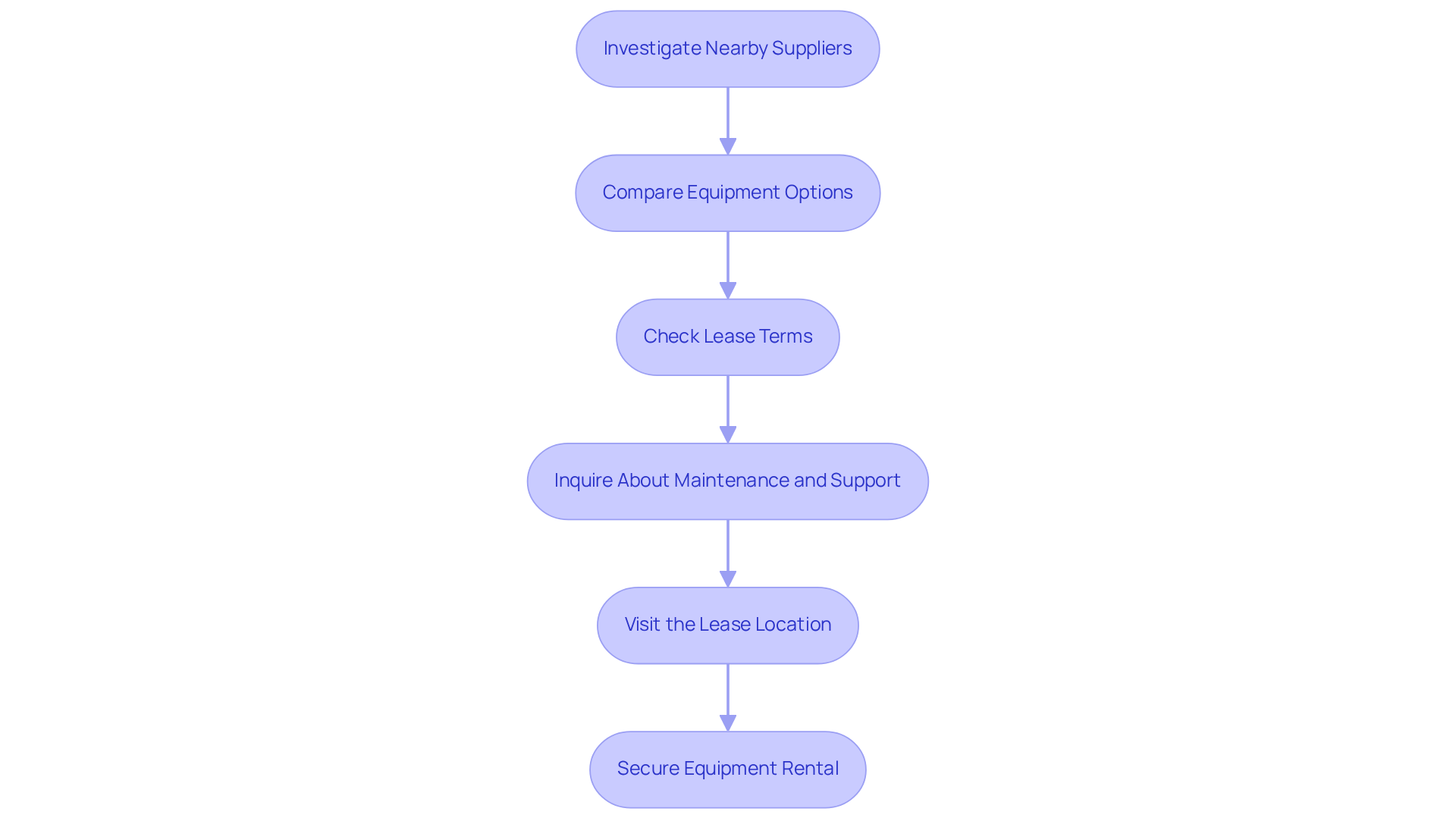Overview
To secure an aerial work platform (AWP) rental near you, follow four essential steps:
- Assess your project needs
- Prioritize safety
- Evaluate local rental services
- Compare equipment options
Understanding your project requirements is crucial, as it lays the foundation for selecting the right equipment. Safety should always be a top priority, ensuring that the chosen AWP meets all necessary standards. Furthermore, evaluating local rental services allows you to identify reliable suppliers who can meet your needs effectively. Finally, comparing equipment options ensures that you select the most suitable AWP for your specific project demands, enhancing overall efficiency and safety.
Key Highlights:
- Aerial work platforms (AWPs) are crucial for construction and maintenance tasks, with various types designed for specific applications.
- Common AWP types include Boom Platforms (telescopic and articulating), Scissor Lifts, Personnel Elevators, Towable Boom Lifts, and Vehicle-Mounted Aerial Devices.
- Scissor lifts accounted for over 46.0% of global revenue in 2022, showcasing their popularity.
- Evaluating project requirements includes assessing height needs, weight capacity, site accessibility, power sources, and weather conditions.
- AWPs with lifting heights above 51 ft are projected to dominate the market with over 45.1% share in 2024.
- Safety considerations include adherence to OSHA and ANSI standards, operator training, use of personal protective equipment (PPE), pre-operational inspections, and emergency procedures.
- The aerial equipment market is expected to grow at a rate of 5.8% from 2020 to 2024, indicating rising demand.
- To rent an AWP, investigate local suppliers, compare equipment options, review lease terms, inquire about maintenance, and, if possible, visit the lease location.
Introduction
Navigating the world of aerial work platform rentals can indeed be a daunting task, particularly given the multitude of options available and the specific needs of each project. It is essential to understand the different types of aerial work platforms (AWPs), as each serves distinct purposes that can significantly impact both efficiency and safety on the job site.
With the increasing demand for these vital tools, the question arises: how can one ensure the selection of the right equipment while adhering to safety standards and project requirements?
This article outlines a comprehensive four-step guide to securing an aerial work platform rental, empowering readers to make informed decisions that enhance productivity and safety in their projects.
Understand Different Types of Aerial Work Platforms
Aerial work platform rental near me provides indispensable tools in construction and maintenance, each meticulously designed for specific applications. Understanding the various types of AWPs is crucial for selecting the right equipment tailored to your project needs. Here are the most common types:
-
Boom Platforms: Equipped with extendable arms, boom platforms excel at reaching high places, making them ideal for building maintenance and construction tasks. They are classified into two primary categories: telescopic (straight) devices that offer maximum reach and articulating (bending) apparatuses that can deftly maneuver around obstacles.
-
Scissor Lifts: These platforms elevate vertically, providing a stable work surface suitable for tasks requiring height without lateral movement. Scissor hoists are widely utilized in warehouses and for indoor projects, where their compact design enhances maneuverability. Notably, scissor platforms represented over 46.0% of the worldwide revenue share in 2022, underscoring their popularity in the market.
-
Personnel Elevators: Designed for one or two workers, personnel elevators are compact and easily fit into tight spaces, making them perfect for indoor maintenance tasks. Their portability ensures quick setup and efficient operation in confined areas, enhancing productivity.
-
Towable Boom Lifts: These portable lifts can be towed to various job sites, offering flexibility for different projects. Their ease of transport makes them a favored choice among contractors who frequently move equipment.
-
Vehicle-Mounted Aerial Devices: Installed on trucks, these structures can be driven directly to job sites, providing both mobility and convenience. They are particularly advantageous for tasks that require quick access to elevated areas across multiple locations.
By understanding these types of AWPs, you empower yourself to select the right equipment for your specific project needs, which is crucial when looking for an aerial work platform rental near me to ensure efficiency and safety on the job site. As the aerial equipment market is projected to expand significantly, reaching USD 33.78 billion by 2030, choosing the suitable AWP is essential for enhancing productivity and adhering to safety standards.

Assess Your Project Requirements and Site Conditions
Before opting for an aerial work platform rental near me, it is crucial to evaluate specific project requirements and site conditions to ensure safety and efficiency.
Height Requirements: Identify the maximum height necessary for your project. AWPs with lifting heights of 20 to 50 ft are commonly preferred for medium-height applications. Notably, those exceeding 51 ft dominate the market, capturing over 45.1% of the total share in 2024. Furthermore, the construction sector captured over 56.4% of the AWP market share by application in 2024, highlighting the importance of AWPs in construction projects.
Weight Capacity: Calculate the total weight of personnel and equipment that will be on the platform. Ensure the AWP can safely support this weight, as inadequate capacity can lead to serious safety risks.
Site Accessibility: Assess the terrain and layout of your job site. Whether the area is flat, uneven, or obstructed will significantly influence the type of AWP required. For example, compact electric scissors are perfect for tight areas and solo tasks, while larger boom models might be required for vast outdoor projects.
Power Source: Assess whether an electric or diesel-powered hoist is more appropriate for your job environment. Electric lifts are typically better for indoor use due to their quiet operation and zero emissions, while diesel lifts are preferred for outdoor applications where power and mobility are essential.
Weather Conditions: Review the weather forecast for the duration of your project. Certain AWPs are not designed for operation in high winds or rain, which can compromise safety and functionality.
By thoroughly assessing these factors, you can select the most appropriate AWP for your project, ensuring both safety and operational efficiency. The aerial equipment market has witnessed a remarkable growth rate of 5.8% from 2020 to 2024, indicating the rising demand for these vital tools across multiple sectors.

Prioritize Safety Standards and Training Needs
Safety is paramount when renting and utilizing aerial lifting equipment (AWPs). To ensure a secure work environment, consider the following essential factors:
- Safety Standards: It is imperative to understand and comply with OSHA regulations and ANSI standards that govern aerial work platforms. Verify that the leasing company meets these compliance requirements to guarantee safe operations.
- Operator Training: All operators must be trained and certified for the specific type of AWP being rented. Training should cover safe operational practices, emergency protocols, and thorough equipment inspections. Although approximately 70% of operators are expected to have received formal training by 2025, it is critical to acknowledge that many workers still operate without adequate training, contributing to the annual injuries reported. As noted by ALC, "Proper training allows aerial lift operators to minimize accident risks."
- Personal Protective Equipment (PPE): Ensure that all personnel working on or near the AWP wear appropriate PPE, including hard hats, safety harnesses, and non-slip footwear. This is vital for minimizing injury risks associated with falls and other hazards. It is essential to confirm that all fall protection equipment is in good working condition.
- Pre-Operational Inspections: Conduct thorough inspections of the AWP before each use. This includes checking for mechanical issues, verifying fluid levels, and ensuring that all safety features are operational. Regular maintenance and adherence to inspection protocols can significantly reduce the likelihood of accidents. Case studies, such as "Aerial Lift Maintenance," underscore the importance of maintaining detailed records to comply with OSHA mandates.
- Emergency Procedures: Develop and communicate clear emergency procedures for potential equipment failures or accidents. Ensure that all personnel are familiar with these protocols to facilitate a swift and effective response in case of an incident.
By prioritizing safety and ensuring comprehensive operator training, the risk of accidents on the job site can be substantially mitigated, fostering a safer working environment.

Locate and Evaluate Local Aerial Work Platform Rental Services
To successfully rent an aerial work platform, follow these essential steps to locate and evaluate local rental services:
-
Investigate nearby suppliers by utilizing online resources, such as service websites and client feedback, to discover local aerial work platform rental near me. Focus on companies renowned for their strong reputation in quality and reliability; customer satisfaction ratings significantly influence your choice. Notably, the American Rental Association reports that rental penetration in the U.S. has reached 56.4%, underscoring the growing reliance on rental services within the construction industry.
-
Compare Equipment Options: Assess the variety of aerial work platforms (AWPs) available for rent at each provider. Ensure they offer the specific equipment that aligns with your project requirements, as the right tools are crucial for operational efficiency. For example, EZ Equipment Rental provides a diverse range of AWPs, including electric scissor lifts and boom lifts, catering to various project needs.
-
Check Lease Terms: Carefully review the lease terms, including pricing, duration, and any additional fees. Clear and reasonable terms are essential for avoiding unexpected costs and ensuring a smooth leasing experience. EZ Equipment Leasing is recognized for its adaptable terms and competitive pricing, simplifying the process for customers to obtain the equipment they require.
-
Inquire About Maintenance and Support: Ask about the maintenance practices of the leasing company. A trustworthy provider should perform regular inspections and maintenance on their equipment to ensure safety and reliability—critical factors for any elevated tasks. As Scott Cannon, CEO of BigRentz, aptly stated, "In this day and age, it just makes sense not to own equipment," highlighting the advantages of renting.
-
Visit the Lease Location: If feasible, visit the lease location to examine the equipment in person. This allows you to evaluate the condition of the AWPs and engage directly with staff to address any questions or concerns. Additionally, customer satisfaction ratings for aerial equipment leasing services in the DFW area can provide insights into the dependability of the supplier.
By following these steps, you can confidently secure an aerial work platform rental near me that meets your project needs while ensuring a safe working environment.

Conclusion
Securing the right aerial work platform rental is essential for ensuring project success and safety. Understanding the various types of aerial work platforms (AWPs) available, evaluating project requirements, prioritizing safety standards, and effectively locating local rental services are critical steps in making informed decisions that enhance operational efficiency. The right equipment not only caters to specific project needs but also fosters a safer work environment.
It is crucial to know the different types of aerial work platforms, such as:
- Boom lifts
- Scissor lifts
- Personnel elevators
Each serving unique functions. Assessing factors like height requirements, weight capacity, site conditions, and power sources is vital to selecting the appropriate AWP. Moreover, prioritizing safety through compliance with regulations, operator training, and thorough inspections can significantly reduce the risk of accidents, ensuring that projects are completed without incident.
In light of the growing demand for aerial work platforms, approaching the rental process with careful consideration and planning is imperative. By following the outlined steps, individuals can confidently secure the right equipment for their projects, ensuring compliance with safety standards and the successful completion of tasks at hand. Embracing these practices will contribute to a more efficient, productive, and safe working environment in the construction and maintenance sectors.
Frequently Asked Questions
What are aerial work platforms (AWPs) used for?
Aerial work platforms are indispensable tools in construction and maintenance, designed for various applications that require working at height.
What are the different types of aerial work platforms?
The common types of aerial work platforms include Boom Platforms, Scissor Lifts, Personnel Elevators, Towable Boom Lifts, and Vehicle-Mounted Aerial Devices.
What are Boom Platforms and their classifications?
Boom Platforms are equipped with extendable arms ideal for reaching high places. They are classified into two categories: telescopic (straight) devices for maximum reach and articulating (bending) apparatuses for maneuvering around obstacles.
Where are Scissor Lifts commonly used?
Scissor Lifts are widely utilized in warehouses and indoor projects, providing a stable work surface for tasks requiring height without lateral movement.
What percentage of the aerial work platform market did Scissor Lifts represent in 2022?
Scissor Lifts represented over 46.0% of the worldwide revenue share in the aerial work platform market in 2022.
What are Personnel Elevators designed for?
Personnel Elevators are designed for one or two workers, making them compact and suitable for indoor maintenance tasks in tight spaces.
What is the advantage of Towable Boom Lifts?
Towable Boom Lifts offer flexibility as they can be towed to various job sites, making them a favored choice among contractors who frequently move equipment.
How do Vehicle-Mounted Aerial Devices function?
Vehicle-Mounted Aerial Devices are installed on trucks and can be driven directly to job sites, providing mobility and convenience for tasks that require quick access to elevated areas.
Why is it important to understand the types of AWPs?
Understanding the different types of AWPs helps in selecting the right equipment tailored to specific project needs, ensuring efficiency and safety on the job site.
What is the projected growth of the aerial equipment market by 2030?
The aerial equipment market is projected to expand significantly, reaching USD 33.78 billion by 2030.




